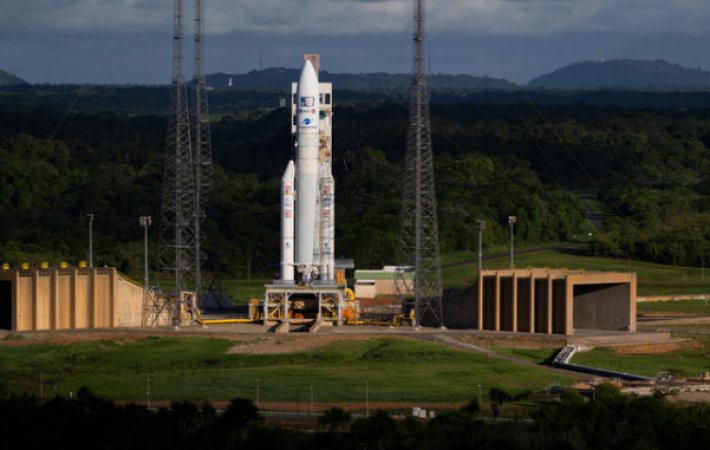
UK: A European spacecraft launched Friday on a ten-year mission to investigate Jupiter and three of its icy moons, which may have once been home to oceans.
From French Guiana in South America, Europe's Ariane rocket launched the journey early that morning.
The robotic explorer, called Juice, will travel to Jupiter in eight years and will explore not only the largest planet in the solar system, but also Europa, Callisto, and Ganymede. The three ice-covered moons may contain deep oceans with the potential for marine life.
Also Read: Pilots from Belarus were given nuclear weapons training by Russia
Then, in what may be the greatest achievement of all, Juice will try to enter an orbit around Ganymede: Only our moon has ever been orbited by a spacecraft.
Astronomers view Jupiter as a miniature solar system due to its numerous moons (at last count, there were 95), and missions like Juice have been long overdue.
Olivier Witasse, the project scientist for the European Space Agency, emphasised that "We are not going to detect life with Juice."
The question of whether there is life elsewhere will be closer to being resolved as scientists learn more about the moons and any potential seas they may contain. That will actually be the mission's most fascinating aspect, he said.
Juice is travelling 4 billion miles (6.6 billion kilometres) to Jupiter via a convoluted, lengthy route.
While circling Jupiter, it will make 35 flybys of the moons, coming within 125 miles (200 kilometres) of Callisto, 250 miles (400 kilometres) of Europa, and 125 miles (200 kilometres) of Ganymede. The main objective of the 1.6 billion euro (nearly $1.8 billion) mission, Ganymede, will then be orbited after applying the brakes.
Also Read: In Russian weapons Ukraine claims to be discovering more Chinese components
Beyond Mercury, Ganymede is the largest moon in the solar system. It also has its own magnetic field and brilliant auroras at its poles.
Its underground ocean, which is believed to contain more water than Earth, makes it all the more alluring. Similar remarks can be made about Europa and its purported geysers as well as the heavily cratered Callisto, which Scott Sheppard of the Carnegie Institution, who is not affiliated with the Juice mission, says could be a potential destination for humans given its distance from Jupiter's harmful radiation belts.
These large moons of Jupiter are excellent candidates to search, according to moon hunter Sheppard, who has assisted in the discovery of well over 100 moons in the outer solar system. "The ocean worlds in our solar system are the most likely to have possible life, so these are prime candidates to search," he said.
The spacecraft, which is about the size of a small bus, will depend on gravity-assist flybys of Venus, Earth, and our moon to get there by 2031.
According to Bill Nye, CEO of the Planetary Society, "These things take time, but they change our world. The space advocacy group in California set up a virtual watch party for the launch.
King Philippe and Prince Gabriel of Belgium, two astronauts from France and Germany, Thomas Pesquet and Matthias Maurer, were among the onlookers in French Guiana. The possibility of lightning forced cancellation of Thursday's launch attempt.
For three years, the Jupiter Icy Moons Explorer, also known as Juice, will buzz Callisto, Europa, and Ganymede. In the event that enough fuel is left, the spacecraft will make an attempt to orbit Ganymede in late 2034. If successful, it will circle the moon for almost a year before being sent crashing down in 2035.
Particularly appealing to researchers looking for life outside of Earth is Europa. The intense radiation on Europa because it is so close to Jupiter, however, will force Juice to limit its encounters with the icy world.
Lead is used to shield the delicate electronics on Juice from radiation. Thermal blankets are also wrapped around the 14,000-pound (6,350-kg) spacecraft because temperatures close to Jupiter are typically around minus 380 degrees Fahrenheit (minus 230 degrees Celsius). And to capture as much sunlight as possible at that distance from the sun, its solar panels extend 88 feet (27 metres) from tip to tip.
The eagerly anticipated Europa Clipper, which will launch on SpaceX's more powerful rocket, will arrive at Jupiter before Juice by more than a year because it is even more heavily shielded than Juice. Together, the two spacecraft will conduct a groundbreaking study of Europa.
Also Read: Spanish letter bomb suspect is granted bail by the court
Since the twin Pioneers and later the Voyagers' flybys of Jupiter in the 1970s, NASA has dominated planetary exploration. The only remaining spacecraft at Jupiter is NASA's Juno, which has just completed its 50th orbit since 2016.
Nine of Juice's scientific instruments came from Europe, while only one came from NASA.
According to Witasse, the next step will be to send drills to break through the icy crusts and possibly even a submarine if Juice confirms the existence of underground oceans favourable to past or present life.We must exercise creativity, he said. We may still believe it to be science fiction, but occasionally fiction and reality collide.